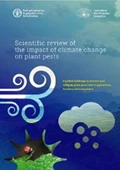
Climate change and intensive agricultural land usage have already resulted in a 49 percent reduction in the number of insects in the world's most impacted areas, according to a new study by researchers of University College London. The study, published in Nature, is the first to show that a combination of rising temperatures and land use changes is causing widespread losses in a variety of insect groups around the world.
Findings of Study:
"Many insects appear to be very vulnerable to human pressures, which is concerning as climate change worsens and agricultural areas continue to expand," said Dr. Charlie Outhwaite (UCL Centre for Biodiversity & Environment Research, UCL Biosciences). Our findings emphasize the importance of taking action to protect natural habitats, slow the expansion of high-intensity agriculture, and reduce emissions in order to mitigate climate change.
"Losing insect populations may be harmful not only to the natural environment, where insects frequently play key roles in local ecosystems, but it may also harm human health and food security, particularly with pollinator losses."
"Our findings may only be the tip of the iceberg because there is limited evidence in some areas, particularly in the tropics, where we discovered quite high reductions in insect biodiversity in the most impacted areas."
The researchers examined a large dataset of insect abundance and species richness from around the world, which included nearly 20,000 insect species and three-quarters of a million records.
The researchers compared insect biodiversity in different areas based on how intensive agriculture is in the area as well as how much historic climate warming has occurred in the area.
They discovered that in areas with high agricultural intensity and significant climate warming, the number of insects was 49 percent lower than in the most natural habitats with no recorded climate warming, while the number of different species was 29 percent lower. Tropical areas experienced the greatest declines in insect biodiversity as a result of land use and climate change.
The researchers discovered that in areas of low-intensity agriculture and significant climate warming, having nearby natural habitat buffered the losses: where natural habitat covered 75 percent of the land, insect abundance declined by only 7%, compared to a 63 percent reduction in comparable areas with only 25 percent natural habitat cover. Because many insects rely on plants for shade on hot days, the loss of natural habitats may make them more vulnerable to climate change.
According to the researchers, insect declines due to human influences may be even greater than their findings suggest because many areas with long histories of human impacts would have already seen biodiversity losses prior to the start of the study period, and the study also did not account for the effects of climate change.
"The environmental harms of high-intensity agriculture present a tricky challenge as we try to keep up with food demands of a growing population," said senior author Dr. Tim Newbold (UCL Centre for Biodiversity & Environment Research). “We previously discovered that insect pollinators are particularly vulnerable to agricultural expansion, appearing to be more than 70% less abundant in high-intensity croplands compared to wild sites. Careful agricultural management, such as preserving natural habitats near farmland, may help to ensure that vital insects can continue to thrive."
"We need to acknowledge how important insects are for the environment as a whole, and for human health and wellbeing, in order to address the threats we pose to them before many species are lost forever," said co-first author Peter McCann, who conducted the research while completing an MSc at the UCL Centre for Biodiversity & Environment Research.
Scientists at the UCL Centre for Biodiversity and Environment Research are at the forefront of research into human impacts on the planet, such as developing the science that underpins the IUCN's Red List, which quantifies extinction risk, and discovering that changes in land use may be increasing the risks of disease outbreaks like Covid-19, which jump from animals to humans.
The center's new interdisciplinary People and Nature Lab is developing novel approaches, such as citizen science programmes and the use of artificial intelligence, to address these pressing global issues and foster a more sustainable relationship between people and nature.
(Source: University College London)












